Apr 11, 2025

Imagine if you could hire more people to help out on your farm. Now imagine those people have specialized skills that can increase germination, improve your soil structure, protect your crops from abiotic stress and reduce crop residue. Sounds too good to be true, right?
While there aren’t humans you can hire with these specialized skills, there are billions of microbes across your farm that can support your soil health, crop health and yield potential. In return, they need a healthy meal before they can start working.
Every farm has four spheres of impact: the spermosphere, the rhizosphere, the phyllosphere and the detritusphere. By supporting beneficial microbes in one of these spheres, you’ll also positively impact others, improving your soil health, reducing abiotic stress and increasing yield potential.
In a teaspoon of soil, there is roughly one billion bacteria and one million fungi, and in a pea-sized area on the leaf you can find up to 10 million bacteria. All of these microbes play an important role in generating consistent yields and supporting soil and crop health.
Microbes are microscopic organisms that consist of fungi, bacteria, archaea, protozoa, viruses and more. Some are pathogenic, but others are beneficial for your crops. Beneficial microbes support healthy plants, soil and yields by:
These are not the only benefits to your farm, as some microbe subspecies have unique benefits. Growers need an abundant (number), diverse (different types) and active microbiome to perform these positive functions in each sphere. The four spheres of impact are the spermosphere, rhizosphere, phyllosphere and detritusphere.
Unfortunately, 75% of microbes on farms are dormant or too weak to perform their normal functions to support soil and crop health.
Farm microbes are dormant or inactive due to starvation and farming practices that negatively impact the microbiome. Lack of nutrients, moisture and proper food source can lead to dormant microbes. In addition, tillage, excessive agriculture chemical use and monocropping all have a negative impact on your farm’s overall microbiome.
When your soil and crops aren’t supported by beneficial microbes, you’ll be working against nature rather than with it.
Tillage destroys microbial habitats, impacts microbial food sources and can cause soil compaction.
By planting the same crop year over year (also known as monocropping), the nutrients needed by the crop you’re planting are continuously absorbed at higher levels. This creates an imbalance of nutrients and leads to nutrient deficiency.
Without the balanced nutrients needed, the soil microbiology can begin to harbor more pathogenic microbes than beneficial ones.
Excessive agricultural chemical usage can decrease both the abundance and diversity of the microbiome. This can lead to reduced nutrient availability as well as an increase in disease severity. Plus, some pesticides have been found to kill beneficial microbes alongside pathogenic ones.
Outside of farm management practices, your microbiome is also impacted by weather patterns, temperature and UV. For example, drought increases osmotic stress and fluctuates accessibility to nutrients to your crop.
Also, an increase in temperatures can impact microbe activity. Microbes will begin to become inactive once temperatures reach above 86 degrees fahrenheit. This results in a lower diversity of microbes and can lead to poor nutrient uptake later in the season and leaving your crop vulnerable to abiotic stressors and diseases.
The good news is, there are a lot of ways that growers can support their microbiome. Supporting microbes in one sphere can positively impact other spheres, too.
While many of the microbes on your farm may be starving or inactive, there are ways to support them, so they can support your crops. Some common farm practices that support a beneficial microbiome include:
While there are four spheres of influence on your farm, they do not all exist on their own. In fact, each sphere impacts other spheres. So, when growers support the beneficial microbes in one sphere, they are also giving microbes in another sphere a leg up as well.
The spermosphere impacts the rhizosphere and phyllosphere.
The rhizosphere impacts the phyllosphere and detritusphere.
The phyllosphere impacts the detritusphere.
The detritusphere impacts the spermosphere and rhizosphere.
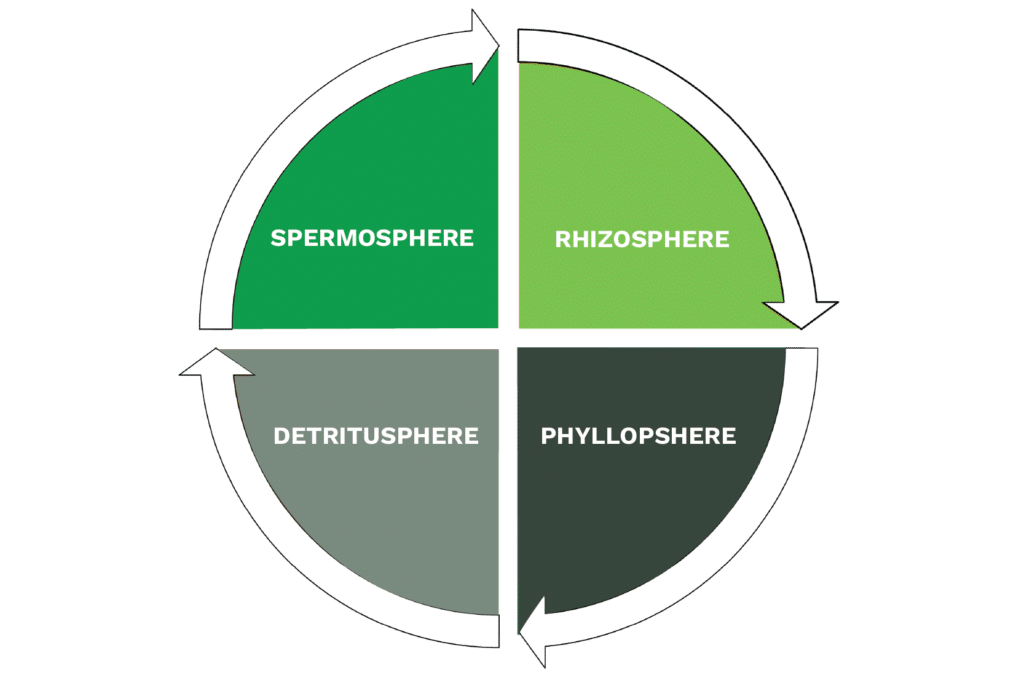
The spermosphere is a short-lived but impactful 2- to 12-mm area around the seed. It’s significant because it’s your seed’s first interaction with the real world. Your seed understands how important the spermosphere is, too!
Seeds naturally secrete enzymes and metabolites to provide beneficial microbes with a carbon source. Unfortunately, your seed can’t secrete enough carbon to feed all the beneficial microbes in its surroundings. Growers should consider investing in a labile carbon product, like PhycoTerra ST as a part of a comprehensive seed treatment plan to feed hungry soil microbes.
PhycoTerra ST is an award-winning seed treatment that feeds beneficial microbes in the spermosphere so they can support germination, early vigor, root-structure development and crop stand establishment. It optimizes the habitat for germination and gives your seed an extra layer of support when it’s most vulnerable.
All of which optimizes your yield potential and positively impacts the rhizosphere and phyllosphere, too.
This will set your seeds up for success. It can be especially beneficial during years of widespread drought, heavy precipitation, or fluctuating temperatures.
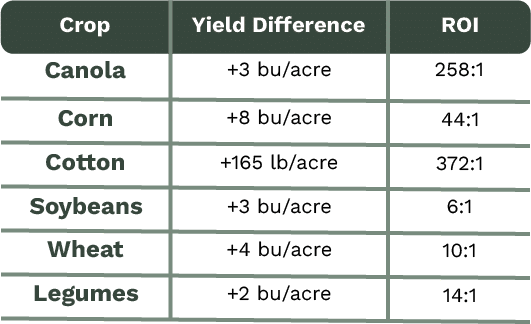
Seed treatments are biological, physical or chemical materials added to a seed prior to planting to support seed development and germination. They typically break down in the first six to eight weeks after planting.
Treatments either create a protective layer around the seed and young plant, or they travel within the plant during or after germination to protect the seed.
Just like any other living species, microbes need food and water to survive. Many of the beneficial microbes in the spermosphere influence the population of microbes in the rhizosphere.
The rhizosphere is an area in the soil where microbes gather around plant roots, which provide them with exudates and other organic matter deposits. How diverse and abundant your soil microbiome is depends on a handful of things, like:
While these areas of high-organic matter may act as ‘kitchens’ for microbes, they aren’t always well stocked enough to feed all the microbes in their surroundings. In fact, 75% of soil microbes are starving and/or dormant due to a lack of food.
Growers can support beneficial microbes on their farm by stocking kitchens in the rhizosphere with a superior, balanced meal like PhycoTerra. When beneficial microbes in your soil are fed, they provide a long list of benefits including:
Considering that 80-90% of soil processes are impacted by the soil microbiome, growers should consider providing soil microbes with all the support they can. Plus, an investment in the rhizosphere will also positively impact the phyllosphere and detritusphere.
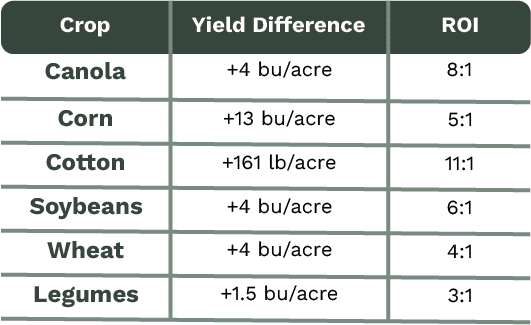
As we mentioned earlier, some subspecies perform specific functions in the soil that benefit crops.
Rhizobia have a symbiotic relationship with plant roots. The bacteria form nodule structures on the root where colonies of bacteria convert atmospheric nitrogen to ammonia that can be used by the plant. This is especially beneficial for legumes.
Bacteria secrete extracellular polymeric substances (EPS) that are soil ‘glues’. These substances stick soil particles together, stabilizing microaggregates, improving soil structure and supporting a healthy root system.
Fungi also have their own way of supporting soil aggregates through hyphae, creating a web-like structure under ground. This holds particles and place and also improves soil structure.
Mycorrhizal fungi act as a nutrient superhighway and move water and nutrients from areas of excess to areas of need within a wide-spanning crop network.
The phyllosphere is a microscopic region around the leaves and above ground tissue where bacteria and fungi live. There are less microbes here compared to the rhizosphere, but there is still a notable amount of microscopic life (1 to 10 million bacteria in a cm2 of leaf surface).
This sphere impacts ecological functions like plant fitness, abiotic stress, and nutrient acquisition by managing environmental impacts on leaves like UV, moisture and heat stress.
There are a few ways beneficial microbes end up in the phyllosphere. Some come from the spermosphere during germination. Some are derived from the plant themselves.
Others come from the rhizosphere, either from germination or they’re moved from the rhizosphere to the phyllosphere. For example, during heavy rain showers, soil can splash onto your plant, moving microbes from the rhizosphere to phyllosphere. Animals, insects, and wind can also move microbes from the rhizosphere to the phyllosphere.
The phyllosphere is the only region with direct interaction with the atmosphere, plants and microorganisms. The contact with the atmosphere makes the environment especially harsh with fluctuating weather conditions. These conditions can impact survival, growth and dispersal rate of leaf microbes. The phyllosphere microbiome can change in as little as a day.
The more abundant, diverse and active the microbiome at the phyllosphere, the more likely your plants are to withstand abiotic stressors – and increase yield potentials. One way growers can support beneficial microbes in the phyllosphere is by feeding them a mix of proteins, lipids and carbohydrates like PhycoTerra FX.
The phyllosphere is a food desert, so providing leaf microbes with a food source is essential for their survival and your crop’s wellbeing. Once fed, abundance and diversity of the microbiome increases and your crop is better able to withstand stressors, driving plant health.
The phyllosphere is the least studied of all the spheres, but emerging evidence suggests it’s incredibly important for plant development as your crop’s first line of defense. Some other benefits of a well-fed microbiome in this sphere include:
*Microbes secrete EPS similar to the rhiozsphere but with different functionalities, which hold in water on the leaf surface and create biofilms for microbes to thrive.
As most growers know, the healthier the plant the healthier the harvest. Here are some of the results our trials have found when feeding leaf microbes.
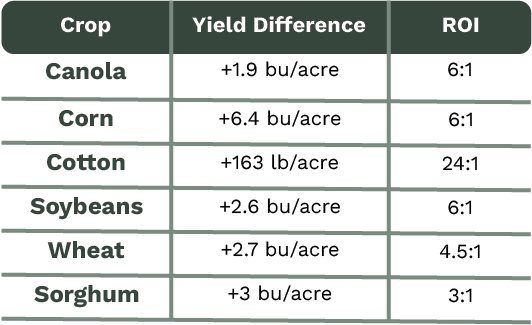
You’ve grown hardy crops by supporting the phyllosphere. When the season comes to an end, it’s time to deal with the crop residue. Traditionally, growers have had three options to deal with crop residue but none of them were ideal.
Tillage mixes the crop residue in with the soil, but also destroys the microbiome. This practice also creates a rapid release of nutrients, leaving little nutrients from your crop residue in your field come spring for your crops.
Applying Biologicals this is a difficult time for biologicals to thrive, with either saturated and cold conditions or hot, dry with high UV the environment does not favor added bacteria and fungi survival post harvest.
Leaving crop residue isn’t always a great option for growers either. This can cause difficulties planting in the spring, clogged machinery, and even pop tires.
What growers need is a way to leave crop residue in the field while increasing mass reduction. Thanks to PhycoTerra, our carbon-rich microbial food, this is now a possibility for growers. This practice feeds microbes, accelerates crop breakdown and and protects the microbiome – without disrupting spring planting plans.
Apply 1-2 quarts of PhycoTerra per acre with your fall burndown or any post-harvest pass to feed hungry microbes and to jump start the residue decomposition process. This practice reduces crop residue mass by 21% compared to winter decomposition alone and increases topsoil temperatures by 5 degrees Fahrenheit by the time of planting the next spring – allowing you to plant a handful of days earlier and increase ROI.
This can provide growers with a $31 to $56 per acre savings based on NPK release, warmer soil at planting, tillage savings, and reduced tillage carbon credits.
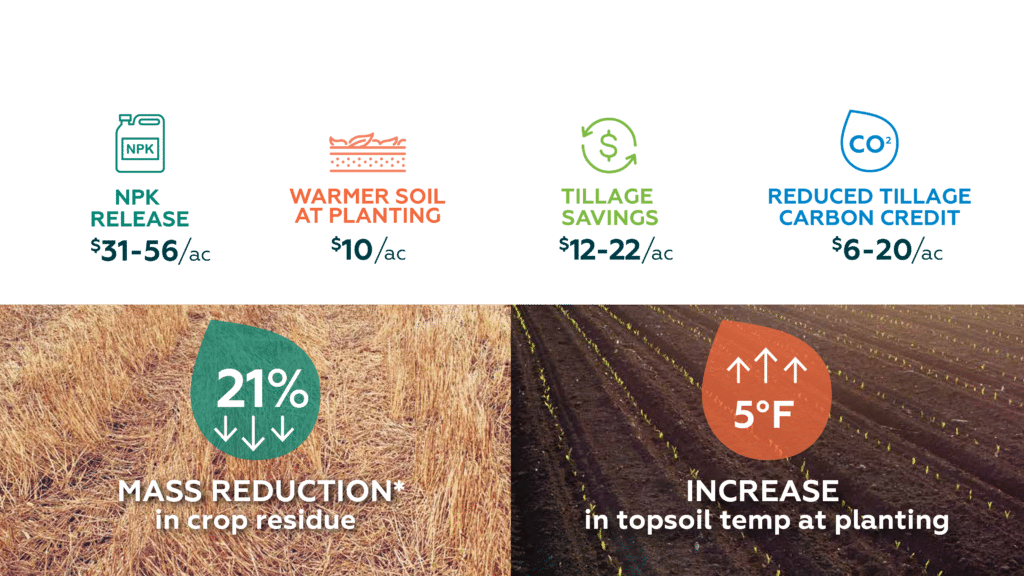
Supporting the detirtusphere also has many long-term benefits, including:
This practice also supports beneficial microbes in the spermosphere and rhizosphere come spring.
Remember when you were a kid and you made a snowman? You started out with one little compact ball of snow, placed it on the ground, and rolled it. As you rolled it, the rest of the snow stuck to the ball and it grew and grew.
The same effect happens when you support each sphere of microbes on your farm. The positive impacts of supporting beneficial microbes at the spermosphere, rhizosphere, phyllosphere, and detritusphere grows and grows. Your farm will be able to achieve more consistent yield potentials year over year, without having to invest in excess agricultural chemicals.
Want to find out which sphere could make the biggest impact on your farm this year? Fill out a contact form and one of our regional managers will be in touch to talk about your unique variables, and which sphere would best support your yield goals.
Note: All trial data is current as of blog posting. For the most up to date trail data, please visit our trials page.